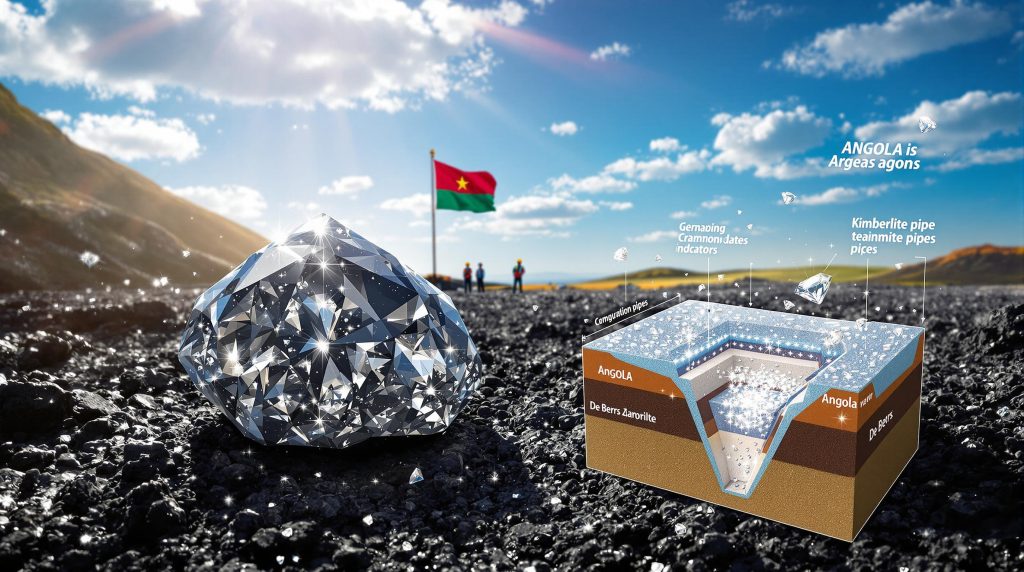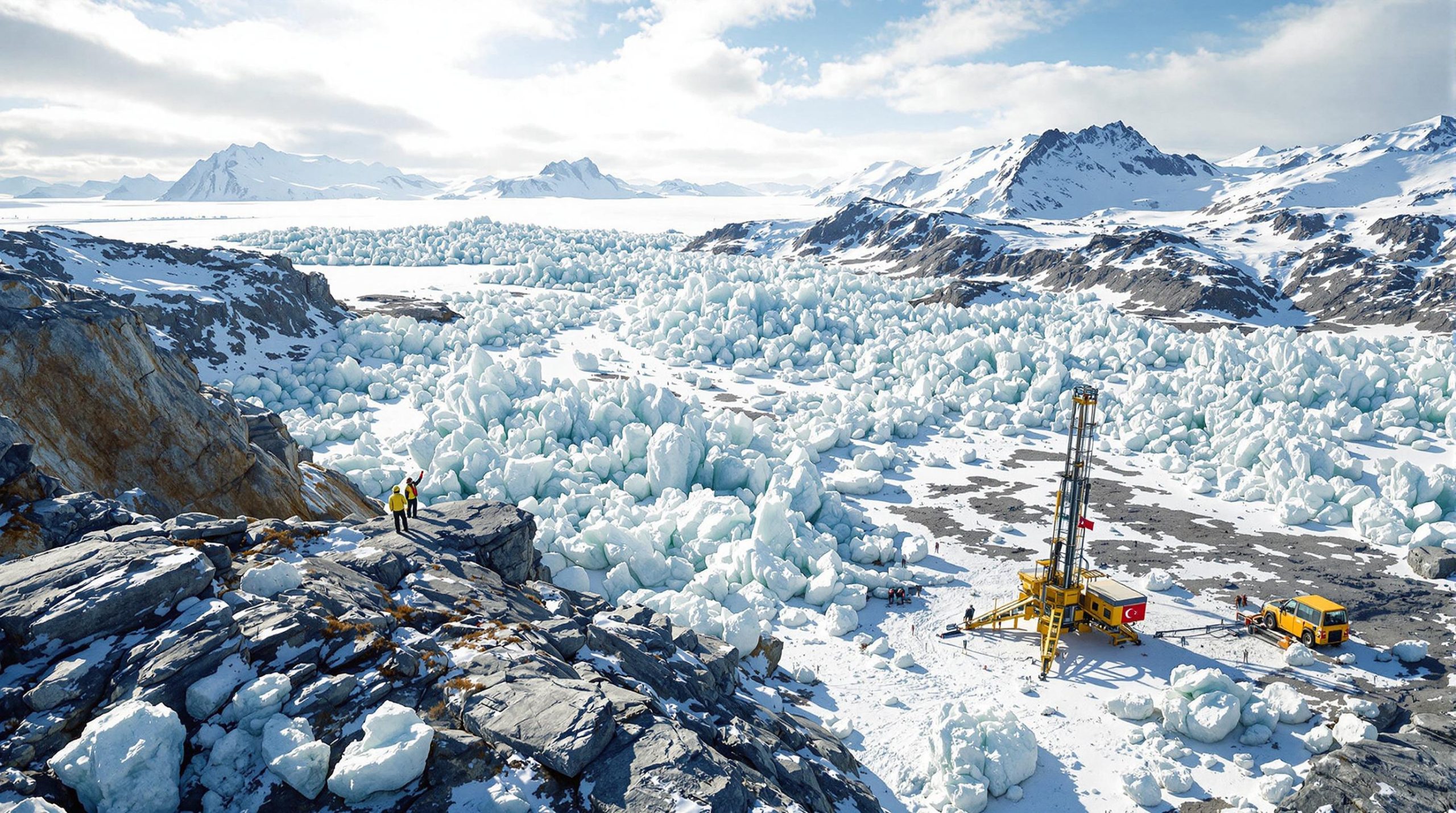De Beers Kimberlite Discovery in Angola: A Landmark Development for Diamond Exploration
In the competitive world of diamond mining, major discoveries have become increasingly rare. However, a recent breakthrough by De Beers Group in Angola has captured the attention of the global mining community, potentially reshaping the landscape of diamond production in Africa.
What is the significance of De Beers' kimberlite discovery in Angola?
The discovery of diamond-bearing kimberlite pipes in Angola represents a pivotal moment for both De Beers and the African diamond industry. This finding comes at a critical time when new primary diamond sources are becoming increasingly scarce worldwide, making it especially noteworthy.
The strategic partnership behind the discovery
The breakthrough emerged from a carefully structured joint exploration initiative between De Beers Group and Angola's state-owned diamond company Endiama. This partnership combines De Beers' world-leading technical expertise in diamond exploration with Endiama's local knowledge and regulatory framework advantages.
This collaboration reflects Angola's strategic push to attract international investment and expertise to develop its vast mineral resources. The government has implemented several mining permitting process reforms in recent years to create a more investor-friendly environment, with this partnership serving as a powerful endorsement of those efforts.
The agreement grants De Beers exploration rights across targeted regions where geological indicators suggested high potential for kimberlite discoveries. Both parties have invested significant resources in this exploration program, demonstrating their confidence in Angola's diamond potential.
Understanding kimberlite and its importance to diamond mining
Kimberlite pipes represent the geological foundation of the diamond industry. These rare volcanic formations serve as natural conduits that transport diamonds from the Earth's mantle – where they form under extreme pressure and temperature approximately 150-200 kilometers below the surface – up to levels where they can be economically mined.
Kimberlite itself is a distinctive igneous rock type that forms vertical "pipes" through the Earth's crust. What makes these formations so valuable is that they're among the few geological structures capable of bringing diamonds from their formation depths to mineable positions near the surface. The volcanic eruptions that created these pipes occurred millions to billions of years ago, moving at extraordinary speeds that prevented the diamonds from reverting to graphite during their ascent.
Primary kimberlite deposits offer significant advantages over alluvial (riverbed) diamond sources:
- More consistent diamond quality and size distribution
- Higher concentration of diamonds per ton of material processed
- Longer mine life and more predictable production planning
- Better control over environmental impacts
- Enhanced security and traceability of diamonds
For these reasons, kimberlite discoveries generate particular excitement in the diamond industry, especially in regions with established diamond potential like Angola.
How does this discovery position Angola in the global diamond market?
The kimberlite discovery has the potential to significantly elevate Angola's position in the global diamond hierarchy, potentially moving it closer to industry leaders like Botswana and Russia.
Angola's current standing in diamond production
Angola currently ranks as the world's 6th largest diamond producer by volume, with annual production averaging approximately 9.5 million carats in recent years. This places it behind major producers like Russia (approximately 30 million carats), Botswana (roughly 24 million carats), and Canada (about 19 million carats).
The country's diamond sector already contributes roughly 5% to Angola's GDP, making it the second most important export after oil. However, Angola's diamond industry has operated well below its potential for decades due to:
- Historical focus on easier-to-access alluvial deposits rather than kimberlite sources
- Limited infrastructure in diamond-rich regions
- Past political instability and civil conflict
- Underinvestment in exploration and mining technology
- Regulatory frameworks that deterred major international investors
Despite these challenges, Angola produced diamonds worth approximately $1.2 billion in 2022, demonstrating the sector's resilience and importance to the national economy.
Potential economic impact of the kimberlite discovery
The development of new kimberlite mines could substantially increase Angola's annual diamond production and value. Industry analysts suggest that a single large-scale kimberlite operation could potentially increase the country's output by 2-3 million carats annually once fully operational.
Beyond direct production increases, the economic ripple effects could be substantial:
- Employment creation: Modern diamond mines typically employ 500-1,500 direct workers, with 3-5 indirect jobs created for each direct position
- Skills development: Technical training and knowledge transfer to build local capacity
- Infrastructure development: Roads, power supplies, and water systems that benefit surrounding communities
- Supply chain growth: Opportunities for local businesses to provide goods and services to mining operations
- Tax revenue generation: Royalties, corporate taxes, and employee income taxes that can fund public services
- Foreign exchange earnings: Increased export revenue to strengthen Angola's currency and macroeconomic stability
For a country working to diversify its economy away from oil dependence, this discovery represents a significant opportunity for sustainable economic development.
What exploration techniques led to the kimberlite discovery?
The discovery highlights the sophisticated multidisciplinary approach required for modern diamond exploration, combining traditional geological knowledge with cutting-edge technology.
Modern diamond exploration methodologies
Finding kimberlite pipes has become increasingly challenging as most surface-exposed deposits have already been discovered. Modern exploration requires a systematic approach:
- Regional targeting: Analysis of geological settings to identify areas with favorable deep geological structures for kimberlite formation
- Remote sensing: Satellite imagery and aerial surveys to identify surface features and vegetation patterns that might indicate underlying kimberlite
- Geophysical surveys: Airborne magnetic and electromagnetic surveys to detect the distinctive magnetic and conductivity signatures of kimberlite pipes
- Indicator mineral sampling: Collection and analysis of soil, stream sediment, and till samples to find minerals like pyrope garnets, chrome diopside, and ilmenite that typically accompany kimberlites
- Ground verification: Follow-up field investigations to confirm preliminary findings
- Drilling programs: Core drilling to physically sample potential kimberlite bodies at depth
This methodical process typically takes years and requires significant investment before a discovery is confirmed. The De Beers-Endiama exploration program likely processed thousands of samples and investigated numerous anomalies before identifying viable kimberlite targets.
Technological innovations in diamond exploration
The Angola discovery benefited from several technological advances that have transformed diamond exploration in recent years:
- Advanced data analytics and AI: Machine learning algorithms that can identify subtle patterns in geological datasets that might indicate kimberlite presence
- Hyperspectral imaging: Technology that can detect mineral signatures from satellite or drone platforms
- Micro-diamond recovery techniques: Methods to identify extremely small diamonds in sample material that would previously have been missed
- Improved geochemical analysis: More sensitive laboratory techniques that can detect trace elements and isotopic signatures associated with diamond-bearing kimberlites
- Portable XRF analyzers: Field equipment that allows real-time elemental analysis of rocks and soils
- 3D geological modeling: Software that integrates multiple data sources to create comprehensive subsurface models
- Low-impact drilling systems: Technologies that reduce environmental disruption during the exploration drilling insights phase
These innovations have significantly improved exploration efficiency while reducing costs and environmental impacts. De Beers, with its substantial R&D investments, has been at the forefront of many of these technological developments.
What are the next steps in developing the kimberlite discovery?
The path from discovery to producing diamond mine involves multiple complex stages, each with specific objectives and challenges.
From discovery to commercial production
The development pathway typically follows this sequence:
-
Resource definition: Extensive drilling programs to determine the size, shape, and grade of the kimberlite pipe. This includes taking core samples at various depths and locations within the discovery area.
-
Bulk sampling: Extraction of larger samples (typically 1,000-5,000 tons) to accurately determine:
- Diamond content (carats per hundred tons)
- Size distribution of diamonds
- Quality profile and value estimation
- Metallurgical characteristics for processing design
-
Preliminary economic assessment: Initial financial modeling to determine if the project warrants further investment based on:
- Estimated capital expenditure requirements
- Operating cost projections
- Revenue forecasts based on diamond quality and quantity
- Infrastructure needs and challenges
-
Pre-feasibility and feasibility studies: Detailed technical and economic assessments including:
- Mining method selection (open pit vs. underground)
- Processing plant design
- Infrastructure requirements
- Environmental and social impact assessments
- Comprehensive financial modeling
- Risk assessment and mitigation strategies
-
Permitting and approvals: Securing necessary governmental and regulatory authorizations:
- Mining license application
- Environmental permits
- Water usage rights
- Community agreements
- Land access arrangements
-
Construction phase: Building the mine and associated infrastructure:
- Site preparation and development
- Processing plant construction
- Power, water, and access infrastructure
- Accommodation and support facilities
- Security systems implementation
-
Commissioning and ramp-up: Gradual increase in production capacity until design throughput is achieved
This comprehensive process ensures that all technical, economic, environmental, and social factors are thoroughly evaluated before full-scale mining begins.
Estimated timeline for development
Based on comparable kimberlite developments globally, the timeline from discovery to production typically follows this pattern:
- Initial assessment phase: 12-18 months for comprehensive evaluation of the deposit
- Advanced exploration and bulk sampling: 12-24 months to collect sufficient data for development decisions
- Feasibility studies and engineering: 12-18 months to complete detailed technical and economic assessments
- Permitting and approvals: 6-12 months depending on regulatory requirements
- Construction phase: 24-36 months for mine development and infrastructure
- Commissioning and ramp-up: 6-12 months to reach commercial production levels
This suggests a total timeline of approximately 5-7 years from discovery announcement to commercial production, assuming no significant delays or complications. Given Angola's improved regulatory environment and De Beers' extensive experience, the development timeline could potentially be accelerated.
Disclaimer: The development timeline represents an industry-standard estimate and may vary significantly based on specific project characteristics, regulatory processes, and market conditions. Investors should not rely solely on these projections for investment decisions.
How does this discovery compare to other recent diamond finds?
Placing the Angola discovery in global context helps understand its relative significance and potential impact.
Global context of diamond discoveries
The discovery in Angola stands out against a backdrop of declining exploration success globally:
- Major new diamond discoveries have become increasingly scarce worldwide over the past two decades
- Many existing diamond mines are reaching maturity, with declining grades and increasing costs
- The last significant kimberlite discoveries occurred in Canada's Northwest Territories in the 1990s
- The Marange diamond fields in Zimbabwe (discovered in the early 2000s) represented the last major new diamond source, though these are primarily alluvial deposits rather than kimberlites
- Russia continues to develop new deposits but primarily in remote and challenging Siberian environments
- Most recent industry focus has been on extending existing mine life rather than finding new deposits
These factors make substantial new discoveries particularly valuable to the global diamond supply chain.
Comparative analysis of recent discoveries
While detailed information about the Angola kimberlite's characteristics remains confidential during the assessment phase, we can make some comparative observations based on regional geology and historical production:
-
Size potential: Angolan kimberlites historically range from small (5-10 hectares surface area) to medium (10-20 hectares) sized pipes. By comparison, premier mines like Jwaneng (Botswana) and Orapa (Botswana) feature pipes exceeding 50 hectares.
-
Grade expectations: Previous kimberlites in Angola have shown grades ranging from 0.5 to 1.5 carats per ton, which compares favorably with global averages (typically 0.4-0.7 carats per ton).
-
Diamond quality: Angolan diamonds are generally known for good quality, with a significant proportion of gem-quality stones. The country has produced several notable large diamonds, including a 404-carat stone found in 2016 that sold for $16 million.
-
Development costs: The discovery likely benefits from better existing infrastructure compared to remote Arctic finds in Canada or Russia, potentially reducing capital expenditure requirements.
-
Operational environment: Angola offers a more moderate climate than Arctic or desert diamond regions, eliminating extreme temperature challenges.
-
Political considerations: Angola's improving investment climate provides a more favorable development environment than many alternative frontier regions.
These factors suggest the discovery could represent a commercially significant addition to global diamond supply, particularly if multiple kimberlites have been identified within the exploration area.
What challenges might affect the development of this discovery?
Despite its potential, the path from discovery to successful mining operation involves navigating numerous technical, economic, and regulatory challenges.
Geological and technical considerations
The development team will need to address several key technical challenges:
-
Deposit geometry determination: Precisely mapping the three-dimensional structure of the kimberlite pipe(s) to optimize mine design. Kimberlites typically narrow with depth and may have complex internal structures.
-
Grade distribution analysis: Diamond content can vary significantly within different zones of a kimberlite pipe. Understanding this distribution is crucial for modern mine planning and economic assessment.
-
Weathering profile characterization: The upper portions of kimberlite pipes often experience significant weathering, affecting both mining methods and processing requirements.
-
Water management: Diamond mining typically requires substantial water resources for processing. Developing sustainable water supply and management systems presents challenges, particularly in regions with seasonal rainfall patterns.
-
Power infrastructure: Processing operations require reliable electrical supply. Developing adequate power infrastructure can be challenging in remote locations.
-
Processing optimization: Each kimberlite has unique mineralogical characteristics requiring customized processing circuits to maximize diamond recovery while minimizing energy and water consumption.
-
Security systems: Implementing comprehensive security protocols to protect high-value assets throughout the mining and processing chain.
These technical challenges require substantial expertise and investment to address effectively. De Beers brings significant experience in overcoming such hurdles from its operations across Africa and Canada.
Regulatory and socioeconomic factors
Beyond technical considerations, several regulatory and socioeconomic factors will influence development:
-
Fiscal regime stability: Ensuring long-term predictability in taxation, royalties, and other fiscal obligations to support investment decisions.
-
Local content requirements: Meeting Angola's expectations for local employment, procurement, and skills development while maintaining operational efficiency.
-
Community engagement: Building productive relationships with local communities through transparent communication, shared benefits, and respect for local cultures and traditions.
-
Environmental compliance: Meeting increasingly stringent environmental standards for water management, biodiversity protection, and rehabilitation planning.
-
Infrastructure limitations: Addressing potential constraints in transportation, telecommunications, and support services in what may be relatively remote areas.
-
Skilled workforce development: Building local technical and management capacity while ensuring operational excellence during the development and early production phases.
-
Artisanal mining interactions: Managing potential interactions with informal diamond mining activities that may exist in the region.
Navigating these challenges requires a comprehensive stakeholder engagement strategy and long-term commitment to sustainable development principles.
How might this discovery impact the broader African diamond industry?
The implications of this discovery extend beyond Angola, potentially influencing diamond sector dynamics across Africa.
Regional implications for diamond production
The discovery could catalyze several shifts in Africa's diamond landscape:
-
Production hierarchy adjustments: If development proves successful, Angola could potentially challenge Namibia for the position of Africa's third-largest diamond producer (after Botswana and South Africa).
-
Exploration investment patterns: Success in Angola may trigger increased mineral exploration significance across the region, particularly in countries with similar geological settings like the Democratic Republic of Congo and Tanzania.
-
Technology and knowledge transfer: Advanced exploration and mining techniques employed in the project could disseminate throughout the regional industry, improving efficiency and discovery rates elsewhere.
-
Competitive dynamics: Increased Angolan production could influence marketing strategies and regional cooperation among African diamond producers, particularly through forums like the African Diamond Producers Association.
-
Infrastructure development: Transportation and power infrastructure developed for the project could benefit broader regional connectivity, potentially supporting other mining operations.
These regional implications highlight the interconnected nature of Africa's mining sector, where major developments in one country often influence investment and operational decisions across borders.
Impact on diamond industry sustainability initiatives
The discovery and subsequent development present significant opportunities to advance sustainability within Africa's diamond sector:
-
Environmental standards benchmark: As a new development, the project can implement cutting-edge environmental management systems from the outset, potentially establishing new benchmarks for the industry.
-
Responsible sourcing showcase: With increasing consumer focus on ethical sourcing, the project could demonstrate best practices in transparent and responsible diamond production.
-
Kimberley Process alignment: Angola has worked to strengthen its implementation of the Kimberley Process Certification Scheme. This new production source offers opportunities to further enhance traceability and compliance.
-
Community development models: The project could pioneer innovative approaches to community development that go beyond traditional corporate social responsibility to create lasting shared value.
-
Local beneficiation initiatives: Angola has expressed interest in developing downstream diamond processing capabilities. This new production source could support efforts to capture more value within the country through cutting and polishing operations.
By incorporating [mining sustainability trends](https://discoveryalert.com.au/
Want to Know When the Next Major Mineral Discovery Happens?
Stay ahead of the market with Discovery Alert's real-time notifications of significant ASX mineral discoveries, powered by the proprietary Discovery IQ model. Visit the Discovery Alert discoveries page to understand why historic discoveries like De Grey Mining and WA1 Resources generated substantial returns, and begin your 30-day free trial today.




